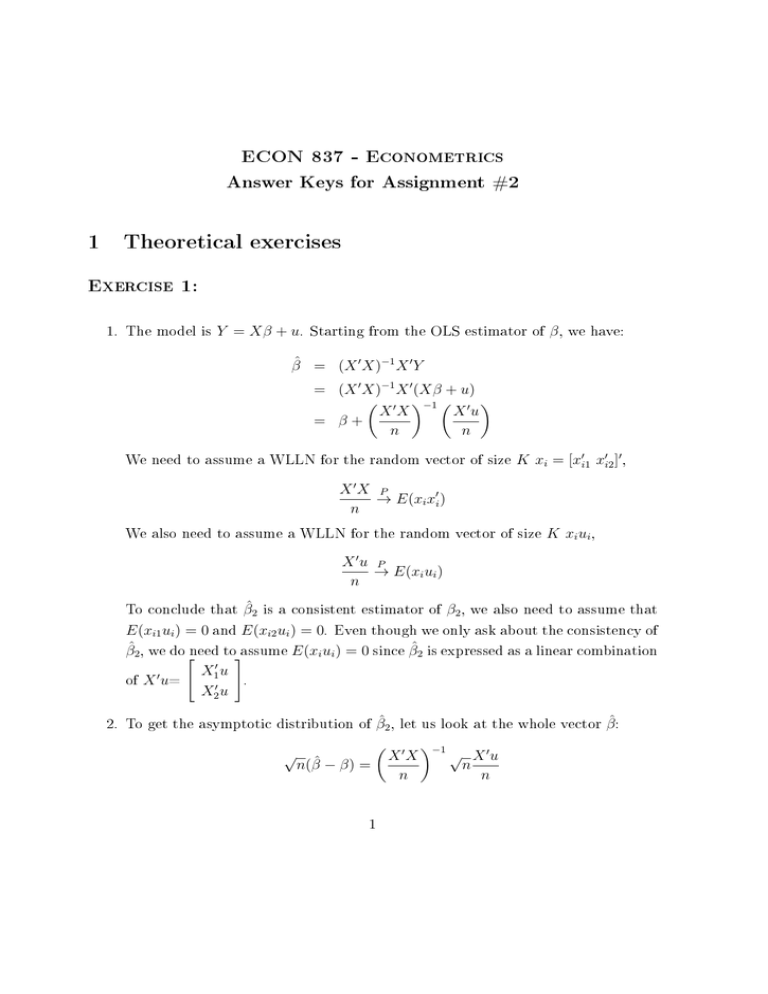1 Theoretical exercises ECON 837 - Econometrics Answer Keys for Assignment #2
advertisement

ECON 837 - Econometrics Answer Keys for Assignment #2 1 Theoretical exercises Exercise 1: 1. The model is Y = Xβ + u. Starting from the OLS estimator of β , we have: β̂ = (X ′ X)−1 X ′ Y = (X ′ X)−1 X ′ (Xβ + u) ( ′ )−1 ( ′ ) Xu XX = β+ n n We need to assume a WLLN for the random vector of size K xi = [x′i1 x′i2 ]′ , X ′X P → E(xi x′i ) n We also need to assume a WLLN for the random vector of size K xi ui , X ′u P → E(xi ui ) n To conclude that β̂2 is a consistent estimator of β2 , we also need to assume that E(xi1 ui ) = 0 and E(xi2 ui ) = 0. Even though we only ask about the consistency of β̂2 , we do[need to]assume E(xi ui ) = 0 since β̂2 is expressed as a linear combination of X ′ u= X1′ u . X2′ u 2. To get the asymptotic distribution of β̂2 , let us look at the whole vector β̂ : √ n(β̂ − β) = ( 1 X ′X n )−1 √ X ′u n n √ e.g. the asymptotic distribution of n(β̂2 − β2 ) is a linear combination of the √ √ asymptotic distribution of X1′ u/ n and X2′ u/ n, hence we need to assume a √ (joint) CLT for X ′ u/ n, namely X ′u d √ → N (0, E(xi x′i u2i )) n Then, we can deduce the asymptotic distribution of β̂ : √ n(β̂ − β) → N (0, [E(xi x′i )]−1 E(xi x′i u2i )[E(xi x′i )]−1 ) d Now to derive the asymptotic distribution of β̂2 , we need to nd the south-east block of the asymptotic variance-covariance matrix of β̂ , which can be done (as in assignment 1) by using the formula of the inverse of a block matrix. 3. The asymptotic variance-covariance matrix of β̂2 is called S2 , that is √ d n(β̂2 − β2 ) → Z2 with V ar(Z2 ) = S2 = AV ar(β̂2 ) The variance of β̂2 when the sample size is xed is V ar(β̂2 ) = V ar([(X ′ X)−1 X ′ u]K2 ,K2 ) and we have P nV ar(β̂2 ) → S2 In other words, for xed n, V ar(β̂2 ) is approximately S2 /n. Exercise 2: 1. The OLS estimator of β1 is: y1 1 y2 2 with X = .. , y = .. . . yT T ∑ tyt β̂1 = (X ′ X)−1 X ′ y = ∑t 2 tt 2 Recall: T ∑ t=1 T (T + 1) t= 2 and T ∑ t2 = t=1 T (T + 1)(2T + 1) 6 Hence: β̂1 = β1 + ∑ 6 tut T (T + 1)(2T + 1) t ∑ By assumption, ut are iid, hence a LLN applies: ( since |t/T | < 1, we conclude that: ut )/T → E(ut ). In addition, P t ∑ ∑ 1 6 P E(ut ) P tut → and tut → 0 (T + 1)(2T + 1) t 2 T (T + 1)(2T + 1) t Finally, we get: β̂1 → β1 . P 2. From 1., we have: T T ( ) ∑ 6 3 ∑ 3/2 β̂1 − β1 = tut ⇔ T tut + op (1) β̂1 − β1 = 3/2 T (T + 1)(2T + 1) t=1 T t=1 By assumption, ut are iid with mean 0 and variance σ 2 . In addition, ∑ ∑ E( tut ) = t×0=0 t t ∑ ∑ T (T + 1)(2T + 1) 2 V ar( tut ) = t2 σ 2 = σ 6 t t 3 ∑ tut ) = 3σ 2 and V ar( 3/2 T t ( ) Hence a CLT applies, and we have: T 3/2 β̂1 − β1 → N (0, 3σ 2 ). 3 d 3. The OLS residuals are ût = yt − β̂1 t. The associated estimator of the variance is: 1∑ 2 û T t t 1∑ = (yt − β̂1 t)2 T t 1∑ = [ut + (β1 − β̂1 )t]2 T t 1∑ 2 1∑ 2 2∑ = ut + (β1 − β̂1 )2 × t + (β1 − β̂1 ) × tut T t T t T t σ̂ 2 = We study the convergence of each term separately: 1∑ 2 P 2 u →σ T t t (β1 − β̂1 )2 × 1∑ 2 (T + 1)(2T + 1) t = (β1 − β̂1 )2 × T t 6 = [T (β1 − β̂1 )]2 × (T + 1)(2T + 1) 6T 2 P → 0 by using the asymptotic distribution found in 2. (β1 − β̂1 ) × 2∑ P tut → 0 T t by using results found in 1. To conclude, we have: σ̂ 2 → σ 2 , which means that it is a consistent estimator of the variance of ut . P 4





